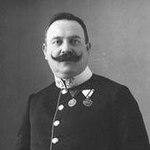Entrance of the Gladiators
"Entrance of the Gladiators" op. 68 or "Entry of the Gladiators" (Czech: Vjezd gladiátorů) is a military march composed in 1897 by the Czech composer Julius Fučík. He originally titled it "Grande Marche Chromatique", reflecting the use of chromatic scales throughout the piece, but changed the title based on his personal interest in the Roman Empire.
Generally, the march is divided into three parts. The first part contains the melody that the trumpet keeps and the several supporting parts. The second third is the section where the low brass (mainly the tubas) take over with the chromatic scale like role. Finally there is a trio, or a softer melodic section, where there is a strong balance between woodwinds and low brass. The trio has a part similar to the second third with a chromatic scale-like sound. The piece is written in cut time and is originally written to be played at standard march tempo, but when played as a screamer it is usually played much faster.
History[]

Czech composer Julius Fučík wrote the march on October 17, 1899 in Sarajevo, where he had been stationed as military bandmaster of the Austro-Hungarian Army since 1897. Originally, he called the piece Grande Marche Chromatique. The march demonstrates the state of the art in playing technology and the construction of brass instruments, which allowed fast and even chromatic gears in all instruments and positions. Fučík was so impressed by the description of a gladiator appearance in a Roman amphitheater in Henryk Sienkiewicz's 1895 novel Quo Vadis that he soon changed the title of his work. The phrase "entry of the gladiators" is known in two descriptions of Pompeii in 1877 and is probably older.
On January 10, 1900 Kapellmeister (1849–1924, Khevenhüller-Marsch) created an arrangement for string orchestra for himself in Graz. In July 1900, the "Concert March for large orchestra", published by Hoffmann’s widow in Prague, is listed under the title Einzug der Gladiatoren by Hofmeister. Further edits followed. In 1903 one of the H.M. Coldstream Guard Band's pre-recorded clay roller advertised by Columbia Records titled Entry of the Gladiators. In the same year a piano score with the title Entry of the Gladiators / Thunder and Blazes ('Donner und Feuersbrünste') was released. The phrase Entrance of the Gladiators, which has existed since at least the 18th century, is also common in English.
Hermann Ludwig Blankenburg published his farewell to the gladiators at the latest in 1904. In 1928, both pieces were recorded by the "Great Odeon Orchestra" on a plate (No. 85204).
Adaptations and uses[]
In 1901, American publisher Carl Fischer published a version of this march, arranged for American wind bands by Canadian composer Louis-Philippe Laurendeau, under the title "Thunder and Blazes".[1] It was during this period that the piece gained lasting popularity as a screamer march[2] for circuses, often used to introduce clowns. Today it is known mainly by this association. Laurendeau's version was also transcribed for fairground organs.
The first portion of the piece has been quoted in such songs including "Goodbye, Cruel World" (1961) by James Darren, "Palisades Park" (1962) by Freddy Cannon, "Yakety Sax" (1963) by Boots Randolph, "Tight Rope" (1972) by Leon Russell, "The Show Must Go On" (1973) by Leo Sayer, covered by Three Dog Night (1974), and "Sideshow" (1974) by Blue Magic. It is also used in Nino Rota's score for Federico Fellini's film La Dolce Vita (1960).[3] In the film version of Godspell Judas hums it when he begins his betrayal and crucifixion of Jesus. (In that adaptation, Jesus and all the disciples are dressed and made-up as clowns.)
The march receives the occasional concert hall performance, such as at the 2007 Last Night of the Proms.[4]
See also[]
References[]
- ^ "Thunder and Blazes". BandMusic PDF Library. Retrieved 2015-11-18.
- ^ Latten, James E.; Chevallard, Carl (September 2004). "Review: Teaching Music Through Performing Marches". Music Educators Journal. 91 (1): 62–63. doi:10.2307/3400112. JSTOR 3400112. S2CID 143129325.
- ^ Dyer, Richard (Jul 25, 2019). Nino Rota: Music, Film and Feeling. Bloomsbury.
- ^ Edward Seckerson (2007-09-11). "Last Night of the Proms, Royal Albert Hall, London". The Independent. Retrieved 2008-09-21.
External links[]
- "Notes from BBC Proms webpage for the 2007 Last Night". Retrieved July 6, 2020.[dead link]
- Entrance of the Gladiators: Scores at the International Music Score Library Project
- Compositions by Julius Fučík
- 1897 compositions
- Military marches
- Circus music
